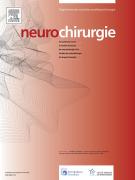Robotic hydrocephalus surgery: A systematic review of the effectiveness in neurosurgical interventions - 14/05/25
Highlights |
• | Hydrocephalus is a neurological condition characterizing the accumulation of cerebrospinal fluid in the brain’s ventricles. |
• | Recently, robotic systems were introduced into hydrocephalus surgery, and studies show that robotic systems are accurate. |
• | Almost all the studies showed robotic success with rare complications like minor bleeding or conversion to manual surgery. |
• | Robotic assistance in hydrocephalus offers potential for advancement in achieving surgical precision and increased safety. |
Abstract |
Background |
Hydrocephalus is an abnormal buildup of cerebrospinal fluid (CSF) deep within the brain, resulting in clinical symptoms, including disorientation, vision disturbances, headaches, cognitive and developmental impairment. Traditional non-navigated surgical treatment, with ventriculoperitoneal (VP) shunt and endoscopic third ventriculostomy (ETV), may lead to complications such as shunt obstruction and inaccurate catheter placement. Robotics-assisted (RA) surgery has potential to improve precision of procedures. The objective of this systematic review is to assess the clinical effectiveness, complications, and benefits of RA surgical interventions in the case of hydrocephalus.
Methods |
PRISMA-guided literature search was done in databases including PubMed, Web of Science, Cochrane Reviews, Scopus, and Embase. Inclusion criteria encompassed English language, original, peer-reviewed journal articles in robotic-assisted surgical interventions in hydrocephalus. Patient demographics, robotic systems used, and results were extracted.
Results |
In total, 12 of the articles discussed robotic-assisted interventions for hydrocephalus. The robotic systems used included ROSA, NaoTrac, Remebot, and more. The findings established that the robotic systems are accurate. Almost all the studies showed successful outcomes with minimum robot-related complications like minor bleeding or conversion to manual surgery.
Conclusions |
The evidence supporting the use of robot-assisted surgery for hydrocephalus management remains very limited in the literature. There is currently insufficient evidence to suggest that it offers any significant additional benefits in terms of patient outcomes, safety, or cost-effectiveness compared to conventional neurosurgical methods. Moreover, given the high maintenance costs of robotic workstations and prolonged surgery times, well-designed prospective controlled trials are needed to evaluate robotic effectiveness, compared to navigation-based techniques.
Le texte complet de cet article est disponible en PDF.Keywords : Hydrocephalus, Surgery, Robot, ROSA, Frameless surgery
Plan
Vol 71 - N° 4
Article 101677- juillet 2025 Retour au numéroBienvenue sur EM-consulte, la référence des professionnels de santé.
L’accès au texte intégral de cet article nécessite un abonnement.
Déjà abonné à cette revue ?


